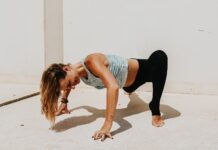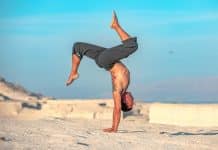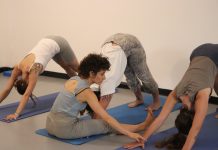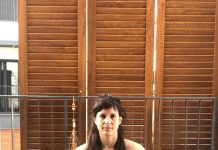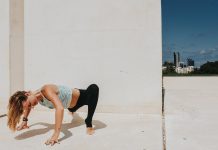Ashtanga Vinyasa combines dynamic, intensive physical activity with deep, rhythmic, active breathing and deep focus. Ashtanga helps the practitioner realize her physical potential, and also improves mental faculties. This combination results in flexibility, strength, physical fitness and high endurance, both physical and mental, as well as improved analytical abilities and sensory perception.
The Ashtanga Vinyasa practice combines four primary components:
Bhandas – energetic seals which balance the bodily functions and help to efficiently stabilize the body while transferring from one Asana (pose) to the next, and within each Asana.
Pranayama – a practice called “Ujjayi” breathing which opens up the chest, improves concentration, and brings energy to the body.
Vinyasa – a flow which helps release the back muscles and move the body’s energy so as to increase the heart rate and improve cardiovascular endurance.
Drishti – focusing the gaze towards a specific point, quieting the mind’s hectic activity.
Ashtanga Vinyasa Yoga focuses on a dynamic flow between the poses. There is an emphasis on the process of moving from one pose to the next, rather than just on sustaining the pose. As well as connecting the poses to each other, Vinyasa is also a connection between movement and breath. The breath is active, and dictates the rhythm of motion.
The practice is comprised of fixed sets of exercises. Every series begins with the Sun Salutation and standing poses (“the opening poses”). Following this, the practitioner moves on to practice one of the sets, according to his or her own ability and the class’s pace.
All of these aspects allow for a practice which is energetic, energizing, empowering and relaxing. Every session ends with the relaxation pose, “Savasana”, which brings serenity, introspection and a sense of rejuvenation.
There are a number of ways to practice Ashtanga Yoga – self practice, Mysore practice (self practice in a group, with a teacher who gives individual guidance to each student), a guided class (a class in which the content is decided by the teacher), and a counted class – where the teacher gives the pace, and the class normally performs the full set.
The purpose of the Ashtanga practice is to create body heat by increasing the pulse and perspiration. Ashtanga Yoga uses the element of fire (Agni) while utilizing opposite elements to purify the body.
The practice of Ashtanga Vinyasa Yoga has great benefits for the digestive system, improves muscle tone, balances between the two sides of the body, and improves balance.
The History of Ashtanga Yoga
The origins of Ashtanga Vinyasa Yoga’s exercise sets are attributed to ancient texts, known as the Yoga Korunta.
In 1937, Pattabhi Jois began to teach Ashtanga Yoga in the Sanskrit College of Mysore, and later founded the Ashtanga Yoga Research Institute (AYRI – later to become KPJAY).
The following is the story of Nancy Gilgoff, the first woman to study Ashtanga with Pattabhi Jois.


